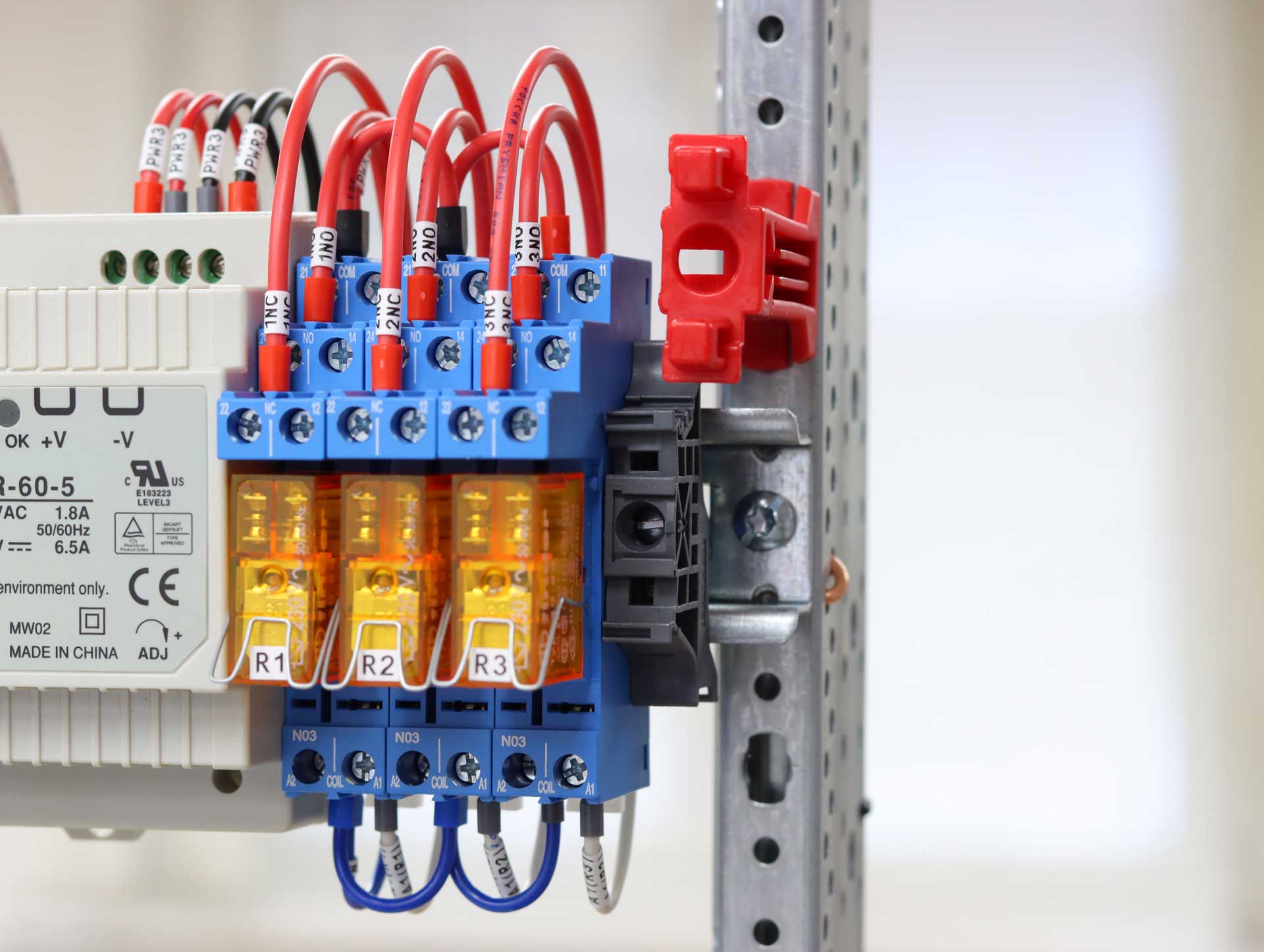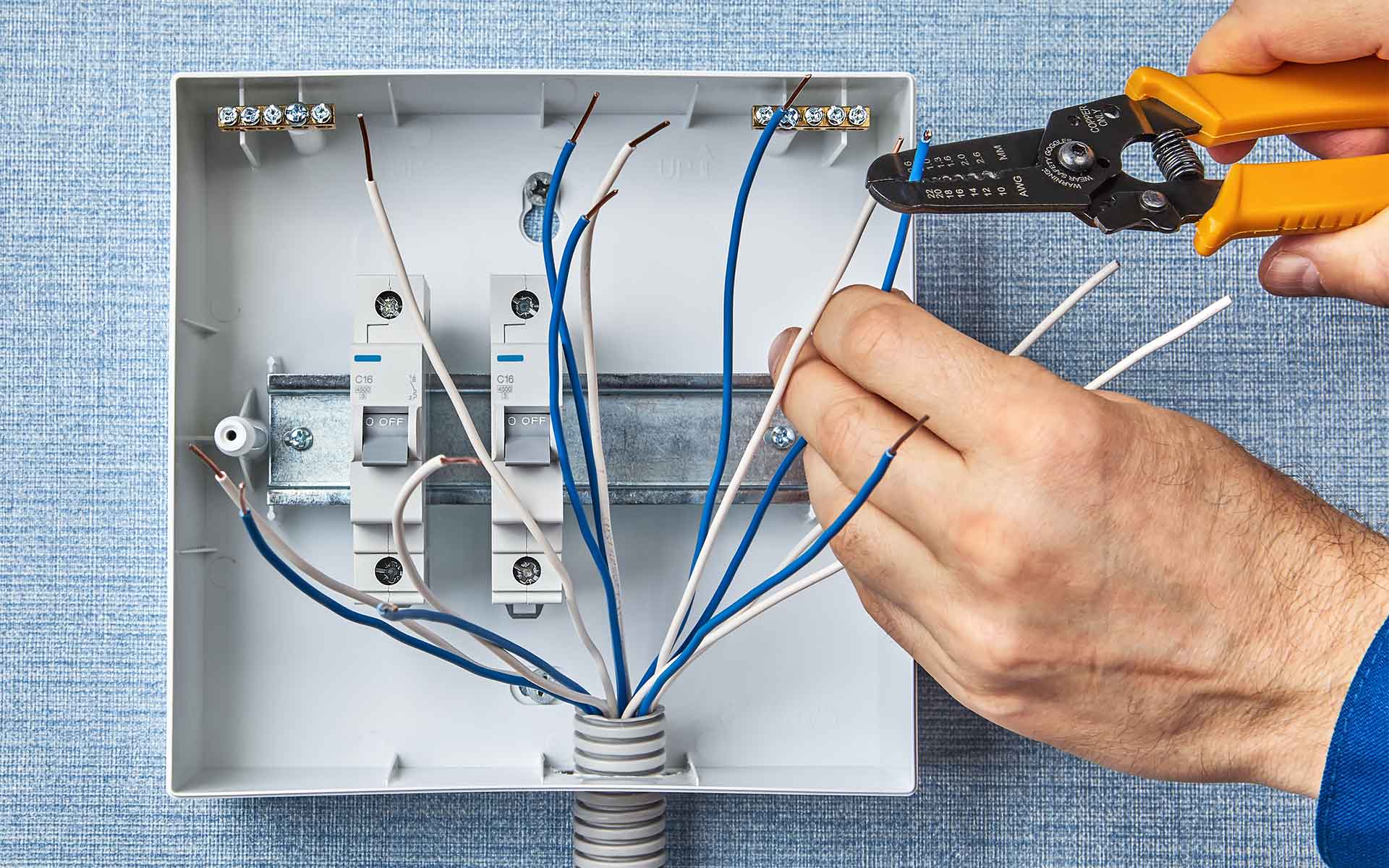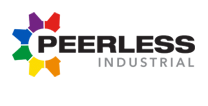The DIN Rail is instrumental to many electrical applications, as it plays a vital role in providing a structured, efficient, and standardized method for mounting and organizing components. Thanks to its simple, standardized design, DIN rail power supplies are used in a broad range of applications in mechanical engineering, industrial automation, logistics, wind power, automotive and process industries, and more.
Today, we’re offering a complete guide to the DIN rail system, including a working explanation, its many benefits, and other useful information about this simple yet indispensable tool for electronic component mounting and organization.
- What is a DIN Rail?
- What is a DIN Rail Used For?
- Electrical Components Commonly Used in DIN Rail Systems
- What are the Benefits of Using a DIN Rail System?
- Application of Various Electrical Components to DIN Rail Systems
- FAQs About DIN Rail Systems
- Shop DIN Rail System Components Online From an Authorized Distributor
What is a DIN Rail?
What is a DIN rail mount? DIN rails are the metal rails inside an electrical enclosure that are used to mount circuit breakers and other types of electrical equipment used by various industries across the globe. Although DIN rails have a relatively simple design, they're vital for installing, maintaining, and operating electrical equipment.
What Does DIN Stand For in DIN Rail?
DIN rail mounts are popular to the point of indispensability in industrial applications due to their standardized dimensions, which were established by the German Institute for Standardization, also known as the "Deutsches Institut für Normung." The original concept was developed and implemented in Germany in 1928 and refined to the present standards in the 1950s.
As you may have guessed, the "DIN" refers to the standardization of the rail's dimensions and specifications, making it a common and widely accepted method for mounting electrical and electronic devices in industrial and control panel applications. This mounting type has been established worldwide and adopted into European (EN) and international (IEC) standards.
DIN rail systems offer a convenient, uniform, and efficient method for installing electrical components in industrial settings, ensuring consistency and interoperability across various manufacturers' parts.
What is a DIN Rail Used For?


As a standardized mounting platform for various electrical and electronic components within industrial and commercial applications, The DIN rail provides a structured and organized method for installing and arranging these parts within control panels, enclosures, and other equipment setups.
DIN rails are essential for creating efficient and reliable control systems in industries such as manufacturing, automation, energy distribution, building management, and more. Components mounted on DIN rails are organized, accessible, and secure, which supports ease and efficiency of maintenance, troubleshooting, and replacement procedures.
Electrical Components Commonly Used in DIN Rail Systems
Countless electrical components are commonly used in DIN rail systems to facilitate the organization, control, and automation of industrial processes. DIN rail systems offer a standardized and efficient component mounting system within space-limited enclosures, control panels, and cabinets. Here are some of the most commonly used electrical components with DIN rail systems.
Circuit Breakers
Circuit breakers are electrical devices designed to protect electrical circuits and equipment from overcurrents, short circuits, and other electrical faults. They serve as a critical safety measure by interrupting the flow of electricity when an abnormal or unsafe condition is detected, preventing damage to wiring, devices, and appliances, and reducing the risk of fires and electrical hazards.
Terminal Blocks
A terminal block is an electrical connector that establishes secure and organized connections between wires, cables, and other electrical components within industrial and commercial applications, providing a convenient and reliable way to terminate, connect, and manage conductors and enabling efficient wiring and distribution of electrical signals.
Relays


Relays, whether electromechanical or solid-state, are used to control high-power circuits or interface between low-power control circuits and high-power loads, which helps increase the service life of electrical applications by reducing maintenance time and costs.
Programmable Logic Controllers
Programmable Logic Controllers (PLCs) are specialized digital computers used in industrial automation and control systems that automate processes, monitor and control machinery and equipment, and perform tasks that require precise and repetitive actions.
Motor Controllers
Motor controllers are specialized components designed to control and manage the operation of electric motors. They provide a variety of functionalities to ensure safe, efficient, and precise motor control in industrial automation, manufacturing, HVAC systems, and other applications where electric motors are a key component.
What are the Benefits of Using a DIN Rail System?
DIN rail systems have many benefits, making them an essential tool for electrical applications. The simple design and features of the DIN rail make them well-suited for countless applications in as many industries. DIN rails anchor all sorts of electrical devices, from circuit breakers to DIN rail embedded systems (comprising multiple single-embedded computers).
Of the many benefits, the following three are clear winners for engineers, technicians, and others who work with DIN rail systems.
Cost Effective
While the initial setup might require investing in the DIN Rail and compatible components, the long-term benefits of easier maintenance, reduced downtime, and the ability to reconfigure systems without extensive rewiring can lead to cost savings over time.
Organized Mounting/Easy Installation
Components designed for DIN Rail mounting typically have standardized fastening mechanisms, such as snap-on clips, that make installation quick and straightforward - no need for custom brackets or mounting solutions.
Also, DIN rails provide a standardized and organized method for mounting various industrial electronic components, such as power supplies, relays, terminal blocks, circuit breakers, and more, simplifying installation, maintenance, and troubleshooting processes.
Space Efficiency
Industrial environments often have limited space, and DIN Rails help optimize available space by allowing components to be mounted vertically or horizontally, reducing clutter and efficiently using panel space.
Application of Various Electrical Components to DIN Rail Systems
Widely used in industrial and commercial applications for mounting and organizing various electrical components, DIN rail systems offer an efficient and standardized way to install components within control panels, enclosures, and other equipment setups.
Countless examples of electrical components can be mounted on DIN rail systems, including relays, circuit breakers, terminal blocks, contactors, PLCs, distribution blocks, and more. The DIN rail system’s standardization ensures compatibility and ease of installation, making them a fundamental part of industrial automation and control setups.
FAQs About DIN Rail Systems
What is the Purpose of DIN Rail Used in Control Panel Wiring?
What is a DIN rail used for in control panel wiring? DIN rails in this capacity mainly serve an essential purpose: they provide a standardized and organized mounting platform for electrical and electronic devices within the control panel.
As a result, using DIN rails in control panel wiring simplifies installation, maintenance, and reconfiguration while contributing to a safer and more efficient control panel design. For this reason, DIN rails are commonly used and relied upon in industrial and electrical applications to hold various components, such as circuit breakers, relays, contactors, terminal blocks, power supplies, and other control devices.
What are the Different Types and Dimensions of DIN Rails?


DIN rails come in various types and profiles, each designed for specific applications and mounting requirements. Therefore, it's essential to select the appropriate DIN rail type based on the particular needs of the application, the size and weight of the devices to be mounted, and the available space within the control panel or equipment enclosure.
All measurements on the DIN rail are in metric units, and they typically have a standard length of 2 meters, which is well-suited for many vertical installations in control cabinets. Throughout its evolution, the DIN rail design has progressed from asymmetrical to encompassing a range of symmetrical designs with varying widths and heights, and they are easily customized by cutting them to the desired length.
- DIN 35mm Standard Rail (EN 60715): The DIN 35mm standard rail is the most widely used type of DIN rail. It features a symmetrical "hat" shape with a 35mm width, designed to accommodate a range of components and accessories. This standard rail is used for mounting various parts, including terminal blocks, relays, contactors, circuit breakers, power supplies, etc. The DIN 35mm rail typically has a height of 7.5mm and a length that can vary based on the specific application.
- DIN 15mm Miniature Rail (EN 60715): The DIN 15mm miniature rail is smaller than the standard 35mm rail, making it suitable for compact spaces or applications with limited components. It’s commonly used for mounting smaller components like signal conditioners, relays, and small control devices. The DIN 15mm rail has a width of 15mm, a height of 5.5mm, and lengths that vary based on requirements.
- DIN 32mm Symmetrical Rail (EN 60715): This rail features a symmetrical shape with a width of 32mm, offering a broader platform for mounting larger components. It is used for applications requiring more space or larger components, such as power supplies and industrial controllers. The DIN 32mm rail typically has a height of 15mm and a length that can vary based on the specific application.
- DIN 15mm x 5.5mm "Top Hat" Rail (EN 50022): This rail earns its name "Top Hat" thanks to a distinctive shape with a wider top portion and a narrower bottom portion, resembling the profile of a top hat. This rail is often used for mounting terminal blocks and control devices in applications where space is limited. The "Top Hat" rail has a width of 15mm and a height of 5.5mm.
- DIN 15mm x 5.5mm "C" Rail (EN 50035): The "C" rail has a "C"-shaped profile with a 15mm width and is commonly used in older installations, and it is suitable for mounting small control components, terminal blocks, and accessories. The "C" rail has a height of 5.5mm.
Does a DIN Rail Carry Power?
While the DIN rail plays a crucial role in providing a secure mounting platform for electrical devices, it does not serve as a conductor for carrying electrical power. However, as the name suggests, a DIN Rail power supply carries and distributes electrical power suitable for powering various industrial devices and electronic components mounted on the DIN rail.
What is a DIN Rail Power Supply?
It’s a component that converts incoming AC or DC power into the required voltage and current for various system parts.
Shop DIN Rail System Components Online From an Authorized Distributor
When electrical applications call for reliable and efficient DIN rail-compatible components, including relays and terminal blocks, Peerless Electronics offers the industry-preferred solutions you need. Easily shop by product category, manufacturer, or price.
We are an authorized stocking distributor for industry-leading suppliers like Carlo Gavazzi and Entrelec, with decades of experience producing innovative products and top-quality electronic components for countless applications. Plus, Peerless Electronic orders are backed by over 50 value add services to ensure the highest quality.





